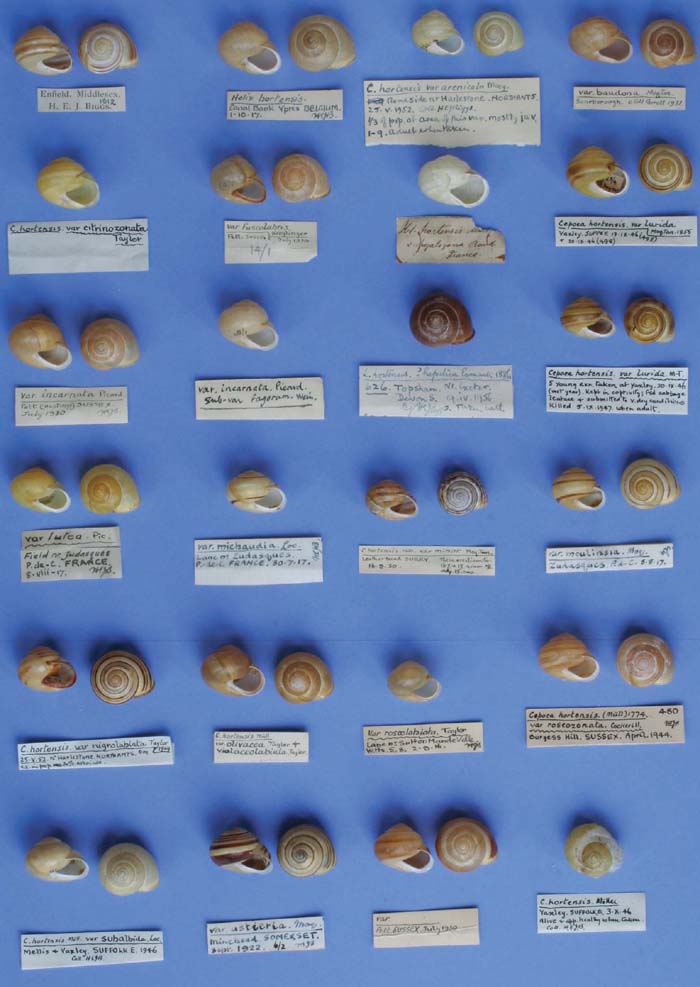The Revd. Bert Biggs was a former president of this Society who found time for a lifelong interest in shells despite a very active life. Born in Edmonton, Middlesex, he saw active service in the 1914-18 war, becoming a teacher for the Church Missionary Society at Kerman in what was then Persia. Following ordination in 1929 he returned to Kerman as pastor of the church there, followed by a period of work in Cairo before becoming rector of Mellis in Norfolk. His final home in a very active “retirement” was a four storey Victorian terraced house in Bromley, Kent. His interests ranged from Mollusca of the Near and Middle East to archaeology but he was interested in all aspects of conchology this was reflected in his large collection and library.
Several of us who were Junior members of this society in the late 1960’s – early 1970’s remember his encouragement of our fledgling interests. I was surprised and pleased that after his death at the beginning of 1973 (when I was 14) he left me some shells that, for one reason or the other, he had not included in his main collection. Among them are a series of varieties and forms of the banded snail Cepaea hortensis L. Since they show a good range of the forms found in this very variable species and many of them have their original labels, I thought a photograph of some of them may be of interest to readers of Mollusc World.
Bert Biggs appears to have found the time to carry out a little of his own research into the determinants of variety in this species, later to be researched by A.J. Cain and others. Here are some of the notes included with the specimens (note that number series refer to the shell banding).
(a)“var. lurida -. 5 young examples taken at Yaxley 20/10/1946 (wet year). Kept in captivity, fed cabbage, lettuce and submitted to very dry conditions. Killed 5/10/1947 when adult.”
(b) “Upwood, Hunts., collected 19/10/1945 as 10345 young. Fed on cabbage. Killed 6/10/1946 as 1:3(45) adult.”
(c)”Yaxley Cross Roads, Suffolk 2/6/1945. The only example amongst a number of normally banded hortensis to show lurida tendancies”
(d) “Taken as young shell Mellis, Suffolk 1946. Fed vegetables; found to be dead 19/10/1948. Last noted alive 11/10/1948”.
(e) “Taken at Yaxley 19/10/1947. Note continuance of lurida banding in a dry year and in wild state.”
The specimens represent collections made at different periods of his life from his time at school in Enfield aged 16 and even include snails collected during the third battle of Ypres, a few days prior to the first battle of Passchendaele, in October 1917 where he was serving as 2nd Lieutenant in the 10th West Riding Regiment! There are also snails collected near to his parish in Norfolk and in the 1960’s on day trips from his home in Bromley including representatives of shells with different numbers or combinations of bands (not illustrated here).
References
Crowley, T.E., (1973). Obituary: Herbert Edwin James Biggs 1895-1973 Journal of Conchology 28:131-132
Taylor, J.W., Monograph of the Land & Freshwater Mollusca of the British Isles vol. 3, Leeds, Taylor Brothers, 1914
Captions for image on page 7
Plate (from top left to bottom right) (Names refer to named “varieties”, many of which are not recognized in recent literature).
 (a) 1:22345 Enfield, Middx. 1912; (b) subalbida Loc. Canal bank, Ypres, Belgium 1917; (c) arenicola Macgillivray. Harlestone, Hants 1952; (d) baudona Moq. Tan. Scarborough (coll. Parrett) 1931; (e) citrinozonata Taylor, Enfield Middx. 1916 fuscolabris Kreglinger, Sussex, 1930; (f) hyalozona Baud. France (= arenicola?) (old label, 19th c.?); (g) lurida Moq. Tan.; (h) incarnata Picard, Hastings, Sussex, 1930; (i) incarnata Picard sub.var. fagorum; (j) cf. hepatica Esmark 1886, Topsham, Devon, 1956; (k) lurida Moq. Tan. Yaxley, Suffolk 1946; (l) lutea Picard, Pas-de-Calais, France, 1917; (m) michaudia Loc., Pasde- Calais, France, 1917; (n) minor Moq. Tan. Leatherhead, Surrey, 1930; (o) moulinsiana Moq.Tan., Pas-de-Calais, France, 1917; (p) nigrolabiata Taylor 1914. Harlestone, Northants, 1952; (q) olivacea Taylor ?; (r) roseolabiata Taylor. Sutton Mandeville, Wilts, 1916; (s) roseozonata Cockerill. Burgess Hill, Sussex, 1944; (t) subalbida Loc. Mellis & Yaxley, Suffolk, 1946; (u) astieria Moq. Tan., minehead, Somerset, 1922; (v) var. ? Sussex, 1930; (w) repaired shell. Yaxley, Suffolk, 1946
(a) 1:22345 Enfield, Middx. 1912; (b) subalbida Loc. Canal bank, Ypres, Belgium 1917; (c) arenicola Macgillivray. Harlestone, Hants 1952; (d) baudona Moq. Tan. Scarborough (coll. Parrett) 1931; (e) citrinozonata Taylor, Enfield Middx. 1916 fuscolabris Kreglinger, Sussex, 1930; (f) hyalozona Baud. France (= arenicola?) (old label, 19th c.?); (g) lurida Moq. Tan.; (h) incarnata Picard, Hastings, Sussex, 1930; (i) incarnata Picard sub.var. fagorum; (j) cf. hepatica Esmark 1886, Topsham, Devon, 1956; (k) lurida Moq. Tan. Yaxley, Suffolk 1946; (l) lutea Picard, Pas-de-Calais, France, 1917; (m) michaudia Loc., Pasde- Calais, France, 1917; (n) minor Moq. Tan. Leatherhead, Surrey, 1930; (o) moulinsiana Moq.Tan., Pas-de-Calais, France, 1917; (p) nigrolabiata Taylor 1914. Harlestone, Northants, 1952; (q) olivacea Taylor ?; (r) roseolabiata Taylor. Sutton Mandeville, Wilts, 1916; (s) roseozonata Cockerill. Burgess Hill, Sussex, 1944; (t) subalbida Loc. Mellis & Yaxley, Suffolk, 1946; (u) astieria Moq. Tan., minehead, Somerset, 1922; (v) var. ? Sussex, 1930; (w) repaired shell. Yaxley, Suffolk, 1946
